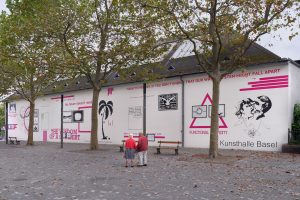For twenty-five years now Kunsthalle Basel has commissioned artistic projects for the back wall of the building, with the intention of keeping alive a dialogue with the citizens and above all with those people who are often afraid of crossing the threshold of a museum or an exhibition space. These interventions are also a way of saying that the institution is alive and that things happen and appointments follow one after the other, even when the opening hours do not correspond to our desire to visit. In some way, these open-air exhibitions that highlight a large external wall, also become a strategy to point the finger inwards, that is, with the hope that the call launched “to everyone and nobody” can be picked up. Following this operative practice (without expecting to impose anything definitively, given that at the end of the cycle, as in a classic exhibition, the intervention is removed) the Kunsthalle dialogues with one of the most significant experiences of contemporary art, namely with that of the so-called public art, that is, with those artistic practices that come out of the white cube to land in the open spaces of the city. And in a city that hosts two colossal sculptures by Jonathan Borofsky in two road junctions, it seems to me that the choice is more than legitimate, I would say almost necessary.
For the two-year period 2021/2022, the author who was called to carry out this intervention is Yoan Mudry. Yoan Mudry (born 1990 in Lausanne, lives in Geneva, CH) is a multidisciplinary artist. He studied at the HEAD in Geneva where he graduated with an MFA in 2014. His work focuses on trying to understand the mechanisms of the flow of images, narratives and information that surround our world. Within a few years, the author created an impressive sequence of performances, installations and paintings, also obtaining residences and participating in numerous public projects. His language is all-encompassing and ranges from hyper-realistic traits to the language of low or so-called popular culture, to cultured contaminations. The result is often playful and not detached from commercial marketing images. Mudry’s eclecticism in the production of images extends to the idea of the brand of himself as an “artist” and to a subtle and ironic critique of capitalist society. As many graffiti artists and other artists before him have shown, from Andy Warhol to Mark Kostabi to Jeff Koons to Superflex, contemporary art cannot be alienated from this debate on the authorship of the sign, on the indistinct proliferation of images, on the possibility of a substitution of the artisan hand given that the indiscriminate use of the mobile phone has made many people producers and consumers of images, that is, prosumers.
This is why the inventory of the images of this author, his repertoire or catalog, if we want to say so, starting from 2010, has a completely horizontal profile, in the sense that he draws in everyday life, in that myriad of information from which all of us we are bombarded, putting on the same level the subjects coming from television, social media, comics, music, art history, pop culture, without neglecting content or topics related to denunciation, socio-political activism and philosophy. The process implemented is that of appropriation and subsequent re-elaboration. Of course, the author is perfectly aware that the distinction is difficult to do: the mass of information is excessive and a lifetime would not be enough to do some sort of order, this is why the approach can sometimes only be randomly selective, given that the rule and the case are terms of a discourse already known and deepened. But what he realizes at the level of the proposed image does not want to be something that is reduced to a caption or an illustration: the idea is to encourage every single person to think and reach reasonable conclusions for themselves. As if to say, it is up to the artist to indicate or launch the message, while it is up to others to collect and rework it. In the words of James Hillman we should speak of “fractured, vicarious, dispersed, shattered images, as if we were in front of a broken mosaic”.
This type of approach clearly emerges also in the intervention “The Future Doesn’t Need Us” which sees phrases juxtaposed with images painted directly on the wall and interspersed with black and white prints. In the words of the author, here we are in the presence of something “not easily digestible” since “the underlying message for me is critical — a commentary, however subjective, on the functioning of our societies, on our behaviors, on the things we do as societies, and on what we accept and foster for economic, political, or cultural reasons, all of which seems to be making the world go very wrong”.
Maddalena B. Valtorta
Info
Yoan Mudry, The Future Doesn’t Need Us
11/09/2021 – 15/05/2022
Kunsthalle Basel
Steinenberg 7
CH-4051 Basilea
T +41 61 206 99 00
info@kunsthallebasel.ch
 Yoan Mudry, installation view, The Future Doesn’t Need Us, Kunsthalle Basel back wall, 2021. Photo: Philipp Hänger / Kunsthalle Basel
Yoan Mudry, installation view, The Future Doesn’t Need Us, Kunsthalle Basel back wall, 2021. Photo: Philipp Hänger / Kunsthalle Basel
 Yoan Mudry, detail view, The Future Doesn’t Need Us, Kunsthalle Basel back wall, 2021. Photo: Philipp Hänger / Kunsthalle Basel
Yoan Mudry, detail view, The Future Doesn’t Need Us, Kunsthalle Basel back wall, 2021. Photo: Philipp Hänger / Kunsthalle Basel
 Yoan Mudry, detail view, The Future Doesn’t Need Us, Kunsthalle Basel back wall, 2021. Photo: Philipp Hänger / Kunsthalle Basel
Yoan Mudry, detail view, The Future Doesn’t Need Us, Kunsthalle Basel back wall, 2021. Photo: Philipp Hänger / Kunsthalle Basel

is a contemporary art magazine since 1980






NO COMMENT